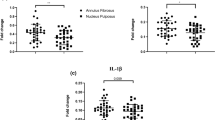Abstract
In pathologic radicular pain of lumbar spinal stenosis, cytokines such as tumor necrosis factor-alpha (TNF-α) and interleukins (ILs) play a crucial role in the pathogenesis of nerve degeneration and pain. We investigated TNF-α and IL-6 levels in the cerebrospinal fluid (CSF) of patients with radicular pain caused by lumbar spinal stenosis (LSS). A total of 30 LSS patients and 10 age-matched controls were examined. CSF samples were obtained adjacent to the level of stenosis in 30 LSS patients, and at the L4–L5 level in the 10 control patients. TNF-α and IL-6 levels in the samples were analyzed using enzyme-linked immunosorbent assays (ELISA). We compared the amounts of TNF-α and IL-6 with severity of pain (low back and leg pain), walking ability, and severity of stenosis (cross-sectional area of dural space). The concentration of IL-6 was significantly higher in LSS patients than in controls, but TNF-α levels were beneath the limit of detection. There was no correlation between IL-6 levels and severity of pain or walking ability (p > 0.05). However, there was a significant correlation between IL-6 levels and severity of stenosis (p < 0.05). The current study showed that the increased CSF IL-6 levels in LSS patients with radicular pain were not correlated with pain severity; although not proven in this study, the increase in CSF IL-6 concentration could indicate pathological nerve damage or degeneration of lumbar radiculopathy represented by the severity of stenosis.




Similar content being viewed by others
References
Brisby H, Olmarker K, Larsson K, Nutu M, Rydevik B (2002) Proinflammatory cytokines in cerebrospinal fluid and serum in patients with disc herniation and sciatica. Eur Spine J 11:62–66
Grönblad M, Virri J, Tolonen J, Seitsalo S, Kääpä E, Kankare J, Myllynen P, Karaharju EO (1994) A controlled immunohistochemical study of inflammatory cells in disc herniation tissue. Spine 19:2744–2751
Hoyland JA, Freemont AJ, Jayson MI (1989) Intervertebral foramen venous obstruction. A cause of periradicular fibrosis? Spine 14:558–568
Ito T, Ohtori S, Inoue G, Koshi T, Doya H, Ozawa T, Saito T, Moriya H, Takahashi K (2007) Glial phosphorylated p38 MAP kinase mediates pain in a rat model of lumbar disc herniation and induces motor dysfunction in a rat model of lumbar spinal canal stenosis. Spine 32:159–167
Konno S, Yabuki S, Sato K, Olmarker K, Kikuchi S (1995) A model for acute, chronic, and delayed graded compression of the dog cauda equina: presentation of the gross, microscopic, and vascular anatomy of the dog cauda equina and accuracy in pressure transmission of the compression model. Spine 20:2758–2764
Myers RR, Wagner R, Sorkin LS (1999) Hyperalgesic actions of cytokines on peripheral nerves. In: Watkins LR, Maier SF (eds) Cytokines and Pain. Switzerland, pp 133–157
Nagashima H, Morio Y, Yamane K, Nanjo Y, Teshima R (2009) Tumor necrosis factor-α, interleukin-1β, and interleukin-6 in the cerebrospinal fluid of patients with cervical myelopathy and lumbar radiculopathy. Eur Spine J 18:1946–1950
Olmarker K, Larsson K (1998) Tumor necrosis factor α and nucleus-pulposus induced nerve root injury. Spine 23:2538–2544
Olmarker K, Rydevik B, Nordborg C (1993) Autologous nucleus pulposus induces neurophysiologic and histologic changes in porcine cauda equina nerve roots. Spine 18:1425–1432
Olmarker K, Nutu M, Størkson R (2003) Changes in spontaneous behavior in rats exposed to experimental disc herniation are blocked by selective TNF-alpha inhibition. Spine 28:1635–1642
Onda A, Murata Y, Rydevik B, Larsson K, Kikuchi S, Olmarker K (2004) Infliximab attenuates immunoreactivity of brain-derived neurotrophic factor in a rat model of herniated nucleus pulposus. Spine 29:1857–1861
Scuderi GJ, Brusovamik GV, Anderson DG, Dunham CJ, Vaccaro AR, Demeo RF, Hallab N (2006) Cytokine assay of the epidural space lavage in patients with lumbar intervertebral disk herniation and radiculopathy. J Spinal Disord Tech 19:266–269
Sekiguchi M, Kikuchi S, Myers RR (2004) Experimental spinal stenosis: relationship between degree of cauda equina compression, neuropathology, and pain. Spine 29:1105–1111
Shamash S, Reichert F, Rotshenker S (2001) The cytokine network of Wallerian degeneration: tumor necrosis factor-α, interleukin-1α, and interleukin-1β. J Neurosci 22:3052–3060
Conflict of interest
No funds were received in support of this study.
Author information
Authors and Affiliations
Corresponding author
Additional information
S. Ohtori, M. Suzuki, and T. Koshi contributed equally to this work.
Rights and permissions
About this article
Cite this article
Ohtori, S., Suzuki, M., Koshi, T. et al. Proinflammatory cytokines in the cerebrospinal fluid of patients with lumbar radiculopathy. Eur Spine J 20, 942–946 (2011). https://doi.org/10.1007/s00586-010-1595-3
Received:
Revised:
Accepted:
Published:
Issue Date:
DOI: https://doi.org/10.1007/s00586-010-1595-3




